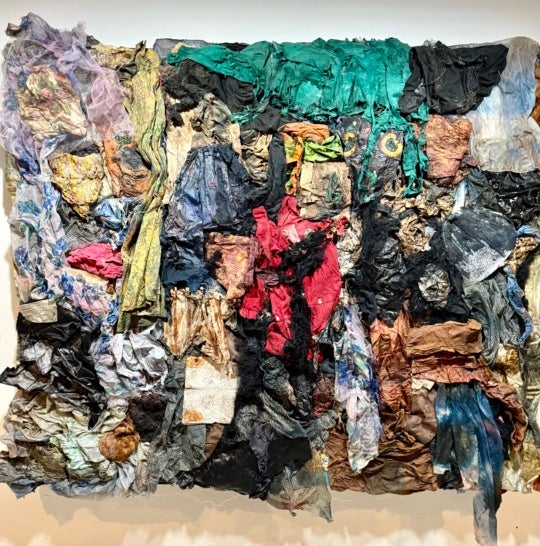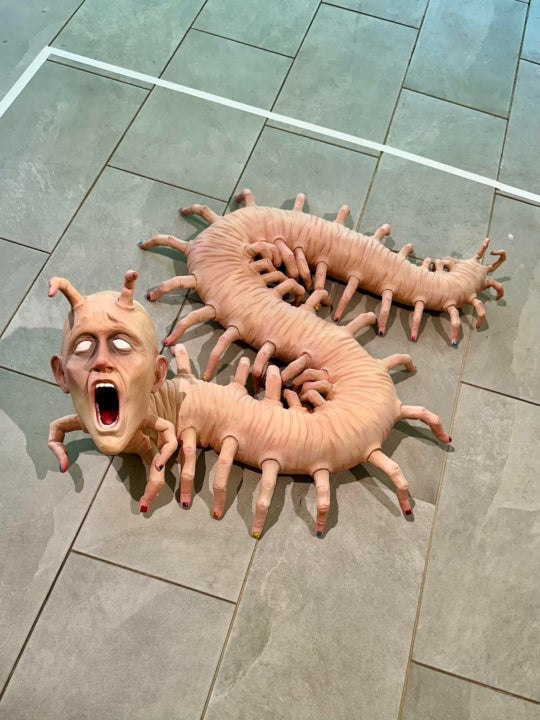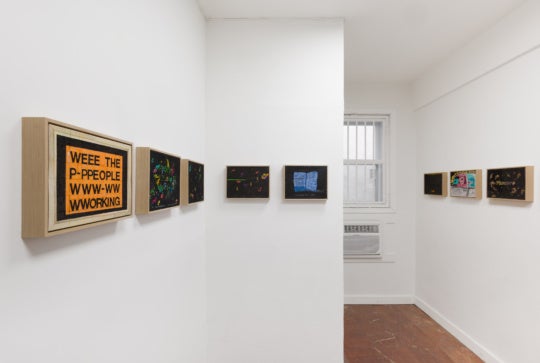
Poet-pioneer Anne Waldman recently gave a reading based on collaborations with visual artists and films made with her partner Ed Bowes at ATHICA in downtown Athens on November 4, 2011.
I took a friend with me to the event, and the first comment he made after we exchanged initial murmurings of pleasure was a non-chalant, “I know that was incredible, but to be honest with you, there were points where I had no concept of what was going on.” This was shocking news. I’m not sure if I’ve ever heard Tyler concede to not “getting it” in the five-odd years I’ve known him.
Tyler had a point, though. Waldman is an idol and one of the few remaining so-called Beat Generation poets to continue her craft. Her poetry reads like a direct translation of her thoughts. It’s not quite stream-of-consciousness, but rather a dissection from a dense, layered meditation. This deeply entrenched, slightly impenetrable quality keeps her work fascinating—the vague, universal themes she often turns to (environment, feminism, warfare, the Buddhist idea of nothingness) can be obtuse in description but are inherently relatable.
Meeting her validated the notions and fantasies I had about her. She speaks the way she writes, and writes the way she thinks, all the while offering a warmth and constancy. Though I lavished in everything she said, I certainly felt that this woman had long understood more than me, more than Tyler, more than many of her Beat-Generation compatriots, which was dauntingly, inspiringly thrilling.

BURNAWAY: My first question is about your collaborations with other artists. What I thought about when I heard of your collaborations was the following quote; you said, “From the Buddhist point of view, neurosis is the difficulty between I, this unsolid thing, and Other. That’s the poet’s job, investigating all the language and imaginations between the two.” Do you consider the other artists’ work part of this Other, or do you consider it to be kind of an extension of yourself and what you’re doing with your work?
Ann Waldman: I’d say it’s not an extension but an exploration; it’s a way to sometimes mirror back or sometimes present a very interesting alternative. It’s a way of getting connected with and ultimately, understanding the Other. I’ve always been attracted to the editing and layering process [of music and film], the way you can move things around, which I think writers do: so much of the work is very much like montage. My husband, [film maker] Ed Bowes, works in these interior ways. I consider the work of infrastructure poetics, you know, creating these projects and programs and schools—the Kerouac School, working with Allen Ginsberg was an amazing collaboration—I consider these projects creative projects, even though they involve a certain level of leadership and administration.
So, the business of Other, that neurosis is our fear of being born alone, dying alone, who is the Other, who are we, what is the human connection, and how can you really get into somebody else’s mind and consciousness, not to mention the consciousness of other animals and everything. So, its a little bit of a step; I don’t know if there are any answers but you know, what comes out of it is the third mind, the notion of coming together in this way that’s not just your mind and somebody else’s mind. There’s this nexus or point of synaptic connection…
BA: Right, I picture it as a kind of reverberation between energies.
AW: Yeah that’s good, definitely.

BA: I’m interested in what you said about your husband working from the interior. What do you mean by that?
BA: Well, he writes first: he works on a script; he works a bit like collaging, but he’s more private in a way. I would say the Manatee / Humanity poem, which was about three years in the making, was a very hermetic project. Except for one section, I was not reading it aloud, not performing it; it became interior. I thought it was more meditative (not that all these projects aren’t all meditative in some way), but he’s got so much going on because there’s these actors and presenters and they’re speaking lines that he’s written or collaged or I’ve co-written with him. Then he’s directing these people and working with photography, which can be very intricate, and he’s fastidious. He can’t just be constantly on about all that, but it goes with the project. So there are all these things he’s got to keep together that are stored in his head. So I see the complexity of it, but I never…it’s never been explained to me.
BA: I’d like to know how you respond to these collaborations. Is it done separately, the other artist does her work and you respond to it immediately, or is it something you combine efforts on?

AW: It depends on the project. There’s a recent collaboration, it’s on exhibit now, with a younger artist named Noah Saterstrom. I had a text called Soldatesque / Soldiering. We had already done a couple of brief collaborations and then we decided we wanted to do something bigger, so I sent him the text. Then he started doing this painted frieze, it’s like 45 feet long. We were going back and forth a little bit and it had started with my text. So he responded to this war theme. And now we’re planning a short video. My husband Ed was in Tucson, Arizona last week and shot the frieze, and I did a little reading. We’re going to do a full reading of the text and maybe [my son] will augment it in some way. Then Noah will put together the images from the film, with sound, and shots of me reading along with the actual installation. So that’s another offshoot off the work itself, which is also a book now. Some of these things have more than one life.
BA: I have another quote of yours!
AW: Oh, okay.
BA: You said in an interview, “Maybe the most revolutionary act these days is not to watch television and to read a book a day at least. And to study another threatened species or culture or language not your own and to keep involved with a local issue. Stay on the case. And vote. Be a guardian.” So, I want to know if you still stand by this.
AW: Yes! I’ve been spending a lot of time down at Occupy Wall Street and I have friends who are involved there. I mean I’m not involved in the inner circles but I’ve been very supportive of the Interdependence Project, which is a collection of Buddhist activists.They have a daily sitting meditation period, and I’ve been down with them [in Zuccotti Park]. It’s very exciting, I felt, especially in how Tahrir Square happened, that it was a template, in a way, for what could happen here. I mean, it’s a very different situation, but I’ve been very heartened by individuals who have been involved. I have a friend who’s a poet and he’s been involved with the workshop that Ambrose Bye and I have been doing at St. Mark’s Bookshop; he’s one of the librarians [at Occupy Wall Street]. So the library was very very exciting to me, and I really think that it should work toward this, and I think it is in certain manifestations around the country and certainly in the UK: the idea of teach-ins and having this street university or free university, which of course existed in Berkeley during the Vietnam War period. So, go back to those ideas of teaching situations, and what’s been organically happening is people show up there, and various celebrities of course, people like Michael Moore, and the Buddhist teacher Robert Thurman was down at Zucotti a couple weeks ago and gave a kind of Dharma talk, and I was able to talk with my limited knowledge; just a sense of transmission and passing things on.

BA: What do you think is the role of artists in protest?
AW: Documentation’s very important, archival stuff. This is what we’re working on at Naropa. After 38 years we have an extraordinary audio and video archive. But that you’re leaving some trace of some Temporary Autonomous Zone, which is the term that comes from Hakim Bey. It’s a book that City Lights published called T.A.Z. He’s kind of an anarchic figure and philosopher-poet. The view is that these things don’t have to last forever, they’re not permanent, they don’t have to become institutionalized and micro-managed. In more and more universities the presidents are like CEOs. It’s a different model, not just for anarchists, but for an alternative way of operating. Then you’re usefulness can be extended, exploded, morphed into something else and you’re not so invested in your immortality.
It’s just very important that you have alternative language to describe what the experience is at Zuccotti Park rather than a canned media interpretation or one person’s point of view. So, the idea is that artists involved with any of this are mirroring reality. It’s better served by a rhizomic model: what the artists mind, I think, can bring to the situation; it’s not just one master narrative or one view: it’s as various as the people involved.




